Kaixiong Gong
Video-R1: Reinforcing Video Reasoning in MLLMs
Mar 27, 2025



Abstract:Inspired by DeepSeek-R1's success in eliciting reasoning abilities through rule-based reinforcement learning (RL), we introduce Video-R1 as the first attempt to systematically explore the R1 paradigm for eliciting video reasoning within multimodal large language models (MLLMs). However, directly applying RL training with the GRPO algorithm to video reasoning presents two primary challenges: (i) a lack of temporal modeling for video reasoning, and (ii) the scarcity of high-quality video-reasoning data. To address these issues, we first propose the T-GRPO algorithm, which encourages models to utilize temporal information in videos for reasoning. Additionally, instead of relying solely on video data, we incorporate high-quality image-reasoning data into the training process. We have constructed two datasets: Video-R1-COT-165k for SFT cold start and Video-R1-260k for RL training, both comprising image and video data. Experimental results demonstrate that Video-R1 achieves significant improvements on video reasoning benchmarks such as VideoMMMU and VSI-Bench, as well as on general video benchmarks including MVBench and TempCompass, etc. Notably, Video-R1-7B attains a 35.8% accuracy on video spatial reasoning benchmark VSI-bench, surpassing the commercial proprietary model GPT-4o. All codes, models, data are released.
AV-Odyssey Bench: Can Your Multimodal LLMs Really Understand Audio-Visual Information?
Dec 03, 2024



Abstract:Recently, multimodal large language models (MLLMs), such as GPT-4o, Gemini 1.5 Pro, and Reka Core, have expanded their capabilities to include vision and audio modalities. While these models demonstrate impressive performance across a wide range of audio-visual applications, our proposed DeafTest reveals that MLLMs often struggle with simple tasks humans find trivial: 1) determining which of two sounds is louder, and 2) determining which of two sounds has a higher pitch. Motivated by these observations, we introduce AV-Odyssey Bench, a comprehensive audio-visual benchmark designed to assess whether those MLLMs can truly understand the audio-visual information. This benchmark encompasses 4,555 carefully crafted problems, each incorporating text, visual, and audio components. To successfully infer answers, models must effectively leverage clues from both visual and audio inputs. To ensure precise and objective evaluation of MLLM responses, we have structured the questions as multiple-choice, eliminating the need for human evaluation or LLM-assisted assessment. We benchmark a series of closed-source and open-source models and summarize the observations. By revealing the limitations of current models, we aim to provide useful insight for future dataset collection and model development.
BIFRÖST: 3D-Aware Image compositing with Language Instructions
Oct 24, 2024Abstract:This paper introduces Bifr\"ost, a novel 3D-aware framework that is built upon diffusion models to perform instruction-based image composition. Previous methods concentrate on image compositing at the 2D level, which fall short in handling complex spatial relationships ($\textit{e.g.}$, occlusion). Bifr\"ost addresses these issues by training MLLM as a 2.5D location predictor and integrating depth maps as an extra condition during the generation process to bridge the gap between 2D and 3D, which enhances spatial comprehension and supports sophisticated spatial interactions. Our method begins by fine-tuning MLLM with a custom counterfactual dataset to predict 2.5D object locations in complex backgrounds from language instructions. Then, the image-compositing model is uniquely designed to process multiple types of input features, enabling it to perform high-fidelity image compositions that consider occlusion, depth blur, and image harmonization. Extensive qualitative and quantitative evaluations demonstrate that Bifr\"ost significantly outperforms existing methods, providing a robust solution for generating realistically composed images in scenarios demanding intricate spatial understanding. This work not only pushes the boundaries of generative image compositing but also reduces reliance on expensive annotated datasets by effectively utilizing existing resources in innovative ways.
Multimodal Pathway: Improve Transformers with Irrelevant Data from Other Modalities
Jan 25, 2024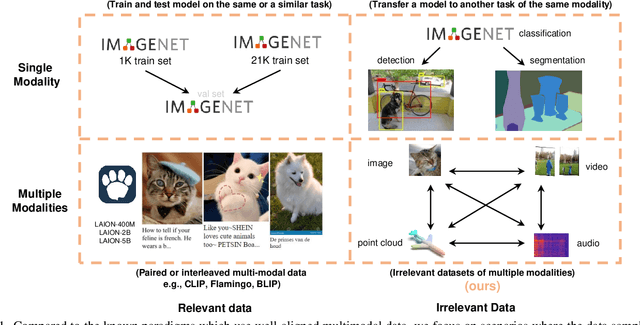

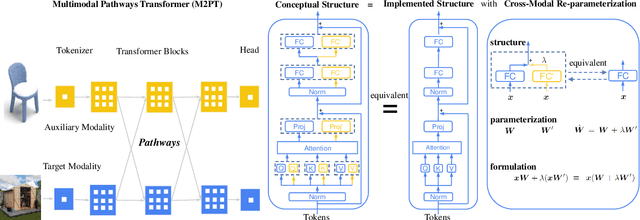

Abstract:We propose to improve transformers of a specific modality with irrelevant data from other modalities, e.g., improve an ImageNet model with audio or point cloud datasets. We would like to highlight that the data samples of the target modality are irrelevant to the other modalities, which distinguishes our method from other works utilizing paired (e.g., CLIP) or interleaved data of different modalities. We propose a methodology named Multimodal Pathway - given a target modality and a transformer designed for it, we use an auxiliary transformer trained with data of another modality and construct pathways to connect components of the two models so that data of the target modality can be processed by both models. In this way, we utilize the universal sequence-to-sequence modeling abilities of transformers obtained from two modalities. As a concrete implementation, we use a modality-specific tokenizer and task-specific head as usual but utilize the transformer blocks of the auxiliary model via a proposed method named Cross-Modal Re-parameterization, which exploits the auxiliary weights without any inference costs. On the image, point cloud, video, and audio recognition tasks, we observe significant and consistent performance improvements with irrelevant data from other modalities. The code and models are available at https://github.com/AILab-CVC/M2PT.
Text-to-3D Generation with Bidirectional Diffusion using both 2D and 3D priors
Dec 07, 2023



Abstract:Most 3D generation research focuses on up-projecting 2D foundation models into the 3D space, either by minimizing 2D Score Distillation Sampling (SDS) loss or fine-tuning on multi-view datasets. Without explicit 3D priors, these methods often lead to geometric anomalies and multi-view inconsistency. Recently, researchers have attempted to improve the genuineness of 3D objects by directly training on 3D datasets, albeit at the cost of low-quality texture generation due to the limited texture diversity in 3D datasets. To harness the advantages of both approaches, we propose Bidirectional Diffusion(BiDiff), a unified framework that incorporates both a 3D and a 2D diffusion process, to preserve both 3D fidelity and 2D texture richness, respectively. Moreover, as a simple combination may yield inconsistent generation results, we further bridge them with novel bidirectional guidance. In addition, our method can be used as an initialization of optimization-based models to further improve the quality of 3D model and efficiency of optimization, reducing the generation process from 3.4 hours to 20 minutes. Experimental results have shown that our model achieves high-quality, diverse, and scalable 3D generation. Project website: https://bidiff.github.io/.
OneLLM: One Framework to Align All Modalities with Language
Dec 06, 2023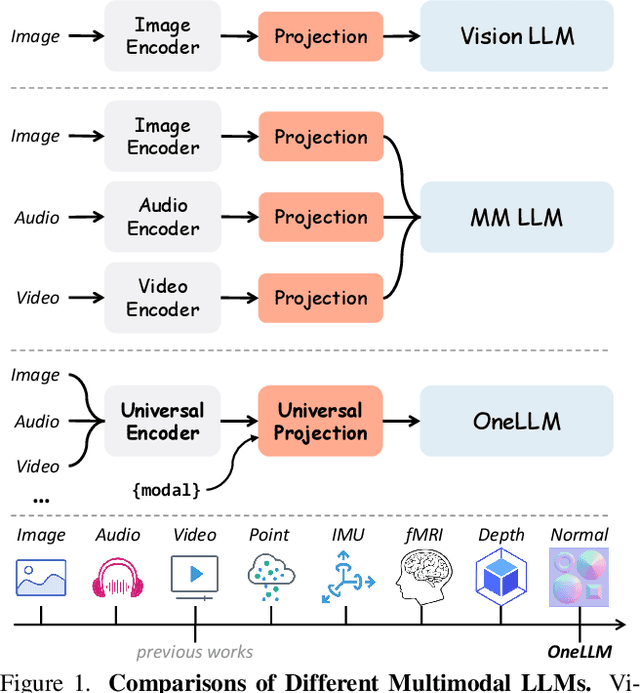
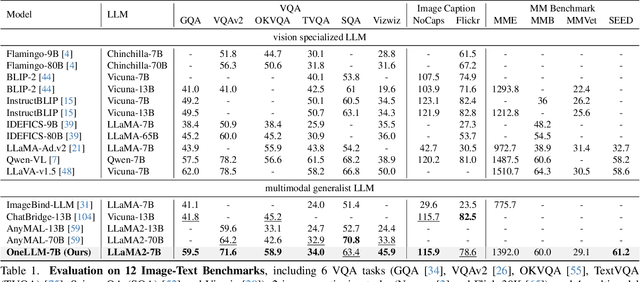
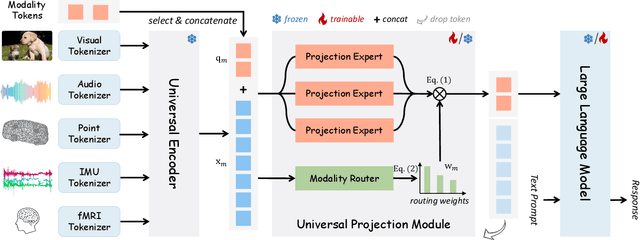
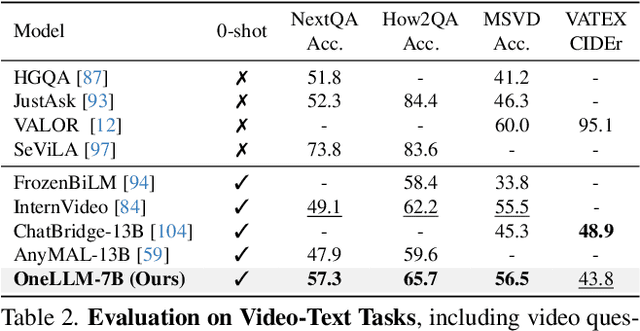
Abstract:Multimodal large language models (MLLMs) have gained significant attention due to their strong multimodal understanding capability. However, existing works rely heavily on modality-specific encoders, which usually differ in architecture and are limited to common modalities. In this paper, we present OneLLM, an MLLM that aligns eight modalities to language using a unified framework. We achieve this through a unified multimodal encoder and a progressive multimodal alignment pipeline. In detail, we first train an image projection module to connect a vision encoder with LLM. Then, we build a universal projection module (UPM) by mixing multiple image projection modules and dynamic routing. Finally, we progressively align more modalities to LLM with the UPM. To fully leverage the potential of OneLLM in following instructions, we also curated a comprehensive multimodal instruction dataset, including 2M items from image, audio, video, point cloud, depth/normal map, IMU and fMRI brain activity. OneLLM is evaluated on 25 diverse benchmarks, encompassing tasks such as multimodal captioning, question answering and reasoning, where it delivers excellent performance. Code, data, model and online demo are available at https://github.com/csuhan/OneLLM
Towards Unified and Effective Domain Generalization
Oct 16, 2023


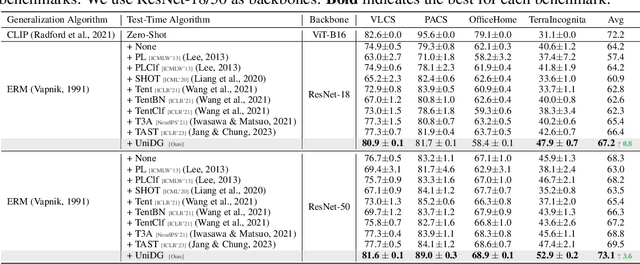
Abstract:We propose $\textbf{UniDG}$, a novel and $\textbf{Uni}$fied framework for $\textbf{D}$omain $\textbf{G}$eneralization that is capable of significantly enhancing the out-of-distribution generalization performance of foundation models regardless of their architectures. The core idea of UniDG is to finetune models during the inference stage, which saves the cost of iterative training. Specifically, we encourage models to learn the distribution of test data in an unsupervised manner and impose a penalty regarding the updating step of model parameters. The penalty term can effectively reduce the catastrophic forgetting issue as we would like to maximally preserve the valuable knowledge in the original model. Empirically, across 12 visual backbones, including CNN-, MLP-, and Transformer-based models, ranging from 1.89M to 303M parameters, UniDG shows an average accuracy improvement of +5.4% on DomainBed. These performance results demonstrate the superiority and versatility of UniDG. The code is publicly available at https://github.com/invictus717/UniDG
Meta-Transformer: A Unified Framework for Multimodal Learning
Jul 20, 2023
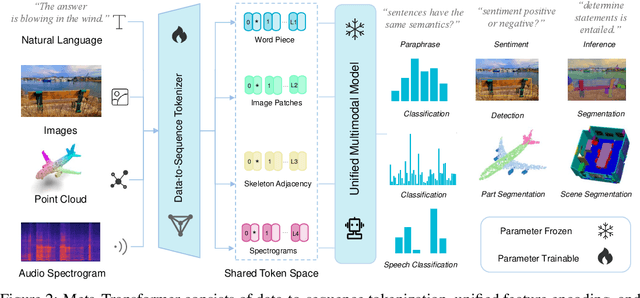
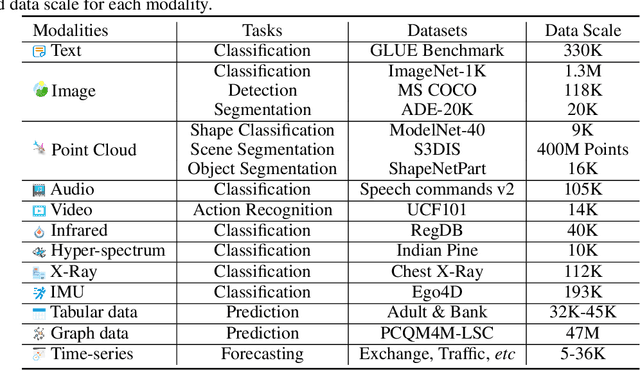
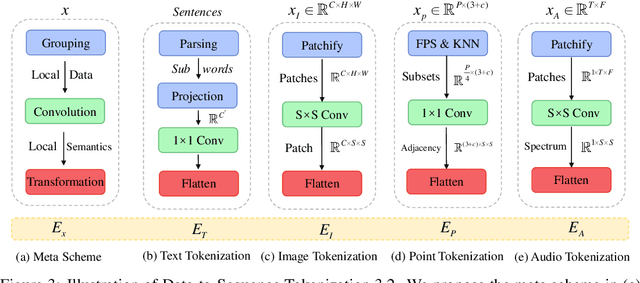
Abstract:Multimodal learning aims to build models that can process and relate information from multiple modalities. Despite years of development in this field, it still remains challenging to design a unified network for processing various modalities ($\textit{e.g.}$ natural language, 2D images, 3D point clouds, audio, video, time series, tabular data) due to the inherent gaps among them. In this work, we propose a framework, named Meta-Transformer, that leverages a $\textbf{frozen}$ encoder to perform multimodal perception without any paired multimodal training data. In Meta-Transformer, the raw input data from various modalities are mapped into a shared token space, allowing a subsequent encoder with frozen parameters to extract high-level semantic features of the input data. Composed of three main components: a unified data tokenizer, a modality-shared encoder, and task-specific heads for downstream tasks, Meta-Transformer is the first framework to perform unified learning across 12 modalities with unpaired data. Experiments on different benchmarks reveal that Meta-Transformer can handle a wide range of tasks including fundamental perception (text, image, point cloud, audio, video), practical application (X-Ray, infrared, hyperspectral, and IMU), and data mining (graph, tabular, and time-series). Meta-Transformer indicates a promising future for developing unified multimodal intelligence with transformers. Code will be available at https://github.com/invictus717/MetaTransformer
Improving Transferability for Domain Adaptive Detection Transformers
Apr 29, 2022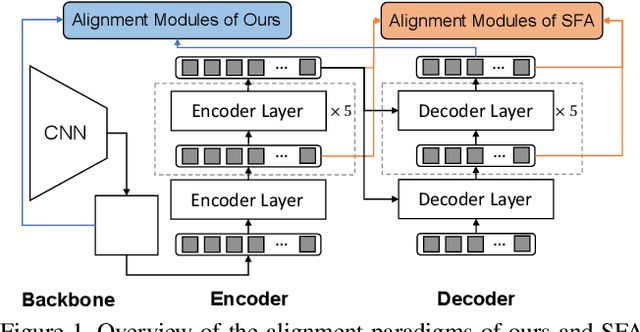
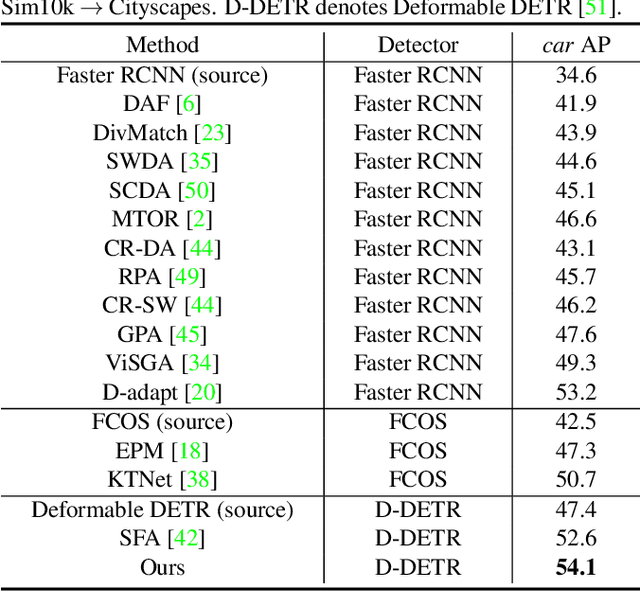
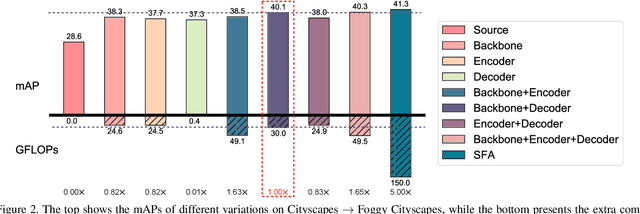
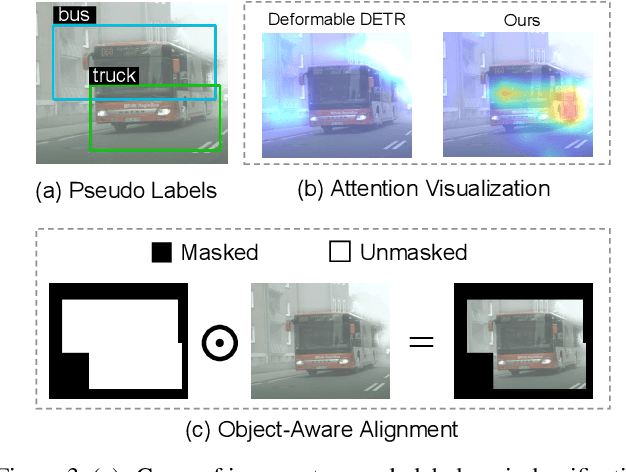
Abstract:DETR-style detectors stand out amongst in-domain scenarios, but their properties in domain shift settings are under-explored. This paper aims to build a simple but effective baseline with a DETR-style detector on domain shift settings based on two findings. For one, mitigating the domain shift on the backbone and the decoder output features excels in getting favorable results. For another, advanced domain alignment methods in both parts further enhance the performance. Thus, we propose the Object-Aware Alignment (OAA) module and the Optimal Transport based Alignment (OTA) module to achieve comprehensive domain alignment on the outputs of the backbone and the detector. The OAA module aligns the foreground regions identified by pseudo-labels in the backbone outputs, leading to domain-invariant based features. The OTA module utilizes sliced Wasserstein distance to maximize the retention of location information while minimizing the domain gap in the decoder outputs. We implement the findings and the alignment modules into our adaptation method, and it benchmarks the DETR-style detector on the domain shift settings. Experiments on various domain adaptive scenarios validate the effectiveness of our method.
Pareto Domain Adaptation
Dec 09, 2021
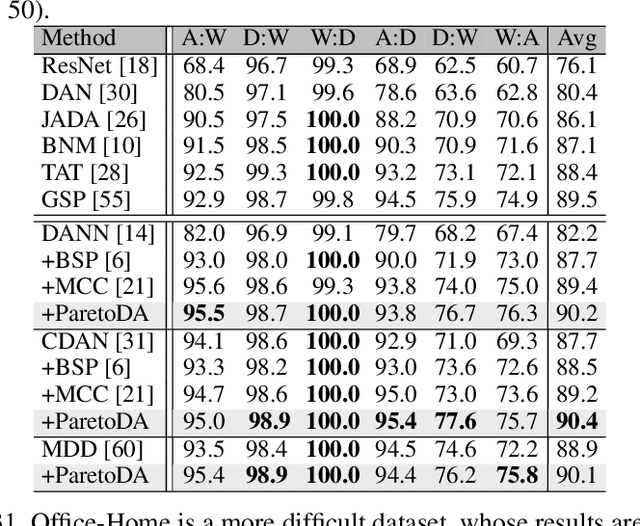
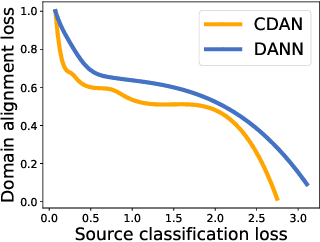
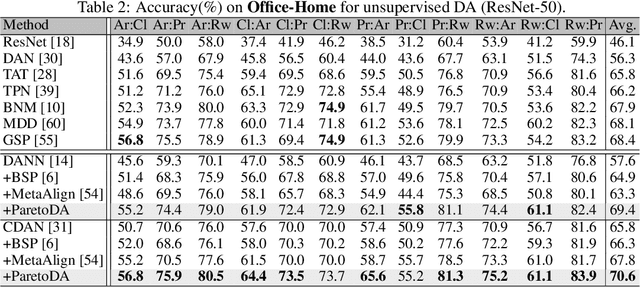
Abstract:Domain adaptation (DA) attempts to transfer the knowledge from a labeled source domain to an unlabeled target domain that follows different distribution from the source. To achieve this, DA methods include a source classification objective to extract the source knowledge and a domain alignment objective to diminish the domain shift, ensuring knowledge transfer. Typically, former DA methods adopt some weight hyper-parameters to linearly combine the training objectives to form an overall objective. However, the gradient directions of these objectives may conflict with each other due to domain shift. Under such circumstances, the linear optimization scheme might decrease the overall objective value at the expense of damaging one of the training objectives, leading to restricted solutions. In this paper, we rethink the optimization scheme for DA from a gradient-based perspective. We propose a Pareto Domain Adaptation (ParetoDA) approach to control the overall optimization direction, aiming to cooperatively optimize all training objectives. Specifically, to reach a desirable solution on the target domain, we design a surrogate loss mimicking target classification. To improve target-prediction accuracy to support the mimicking, we propose a target-prediction refining mechanism which exploits domain labels via Bayes' theorem. On the other hand, since prior knowledge of weighting schemes for objectives is often unavailable to guide optimization to approach the optimal solution on the target domain, we propose a dynamic preference mechanism to dynamically guide our cooperative optimization by the gradient of the surrogate loss on a held-out unlabeled target dataset. Extensive experiments on image classification and semantic segmentation benchmarks demonstrate the effectiveness of ParetoDA
 Add to Chrome
Add to Chrome Add to Firefox
Add to Firefox Add to Edge
Add to Edge